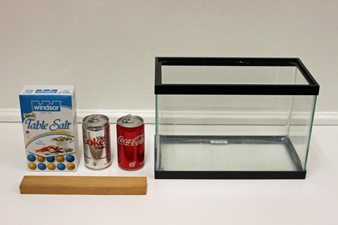Objective:
– To demonstrate that a material’s density is defined as its mass per unit volume.
Apparatus:
- a large aquarium filled with water
- a can of regular soda
- a can of diet soda
- salt
- stir stick

Method A:
Fill the aquarium almost to the top with water. Place a can of regular soda into the water. Make sure that no air bubbles are trapped under the can when you place it in the water. Does it sink or float? Repeat the experiment with a can of diet soda. Does it sink or float? The cans of soda have exactly the same volume, or size. But their density differs due to what is dissolved in the soda.
Regular soda contains sugar as a sweetener. If you look at the nutrition facts on a can of regular soda, you will notice that it contains sugar…a lot of sugar. In some cases a 12 ounce can of regular soda will contain over 40 grams of sugar. Diet sodas, on the other hand, use artificial sweeteners such as aspartame. These artificial sweeteners may be hundreds of times sweeter than sugar, which means that less than a few grams of artificial sweetener is used in a can of diet soda.
The difference in the amount of dissolved sweeteners leads to a difference in density. Cans of regular soda tend to be more dense than water, so they sink. Cans of diet soda are usually less dense than water, so they float.
Method B:
Mix in some salt with the water. Place the cans of soda in the salt water solution. Add enough salt to the water until they both float. Salt water is more dense than regular water. It means that there is more mass in a certain volume of the salt water than there is in the same volume of normal water.
When you add table salt (sodium chloride, NaCl) to water, the salt dissolves into ions, Na+ and Cl-. The volume increases by a small factor, but the mass increases by a bigger factor. There are two reasons. One is simply that the NaCl is much denser than water to begin with, mainly because its ions have more mass than the oxygen and hydrogen atoms in the water molecules.
Also, the ions bind nicely with the water molecules, so that the volume of the saltwater isn’t as big as the water volume plus the salt volume.
Buoyancy Demo: Soda Cans
– Video Created at Utah State University by Professor Boyd F. Edwards and assistants.